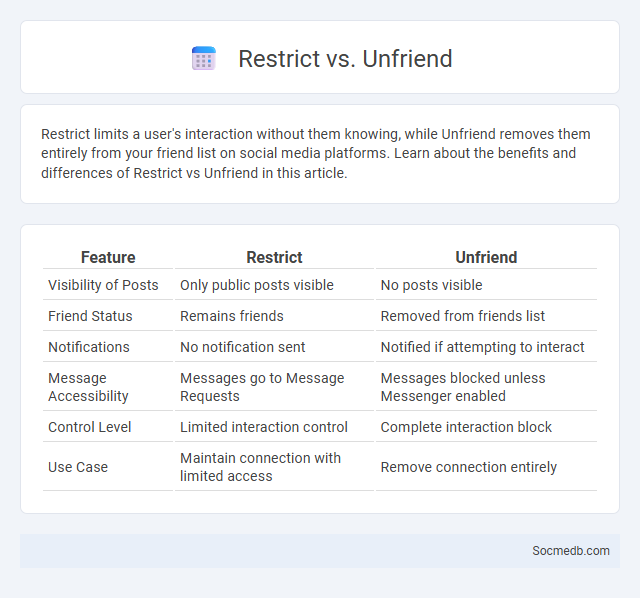
Photo illustration: Restrict vs Unfriend
Restrict limits a user's interaction without them knowing, while Unfriend removes them entirely from your friend list on social media platforms. Learn about the benefits and differences of Restrict vs Unfriend in this article.
Table of Comparison
| Feature | Restrict | Unfriend |
|---|---|---|
| Visibility of Posts | Only public posts visible | No posts visible |
| Friend Status | Remains friends | Removed from friends list |
| Notifications | No notification sent | Notified if attempting to interact |
| Message Accessibility | Messages go to Message Requests | Messages blocked unless Messenger enabled |
| Control Level | Limited interaction control | Complete interaction block |
| Use Case | Maintain connection with limited access | Remove connection entirely |
Understanding Facebook’s Social Tools: Restrict vs Unfriend
Facebook's social tools include the options to restrict or unfriend users, each serving different privacy and interaction purposes. Restrict limits a person's access to your posts without notifying them, creating a subtle boundary while maintaining the connection. Unfriending removes the person from your friend list entirely, cutting off most forms of interaction and signaling a clearer social separation.
What Does “Restrict” Mean on Facebook?
On Facebook, the "Restrict" feature limits the visibility of your posts to a specific user without unfriending or blocking them, allowing you to control their interactions subtly. When someone is restricted, they can only see content you share publicly or posts where they are tagged, preventing them from viewing private posts on your timeline. This tool enhances privacy management and helps users maintain boundaries without causing social friction.
How “Unfriend” Works and Its Consequences
Unfriending on social media removes a user from your friends list, immediately cutting off direct access to your profile, posts, and updates. This action can signal a shift in personal relationships, potentially causing social friction or emotional impact depending on the context and platform algorithms. Your decision to unfriend affects digital visibility and interaction frequency, influencing how you and others experience social networks.
Key Differences Between Restricting and Unfriending
Restricting limits a user's interactions without notifying them, allowing you to control visibility of your posts and story without severing the connection, while unfriending removes the user entirely, cutting off all direct social media interactions and visibility of your profile to them. Restricting is ideal for maintaining a connection with minimal engagement, whereas unfriending is a more definitive action often used to eliminate unwanted contact or preserve privacy. Platforms like Facebook and Instagram provide these tools to tailor social media experiences, enhancing personal boundaries and digital security.
When Should You Use the Restrict Feature?
Use the restrict feature on social media when you want to limit interactions with specific users without blocking them completely, such as in cases of minor harassment, annoying comments, or potential spammers. This feature hides the restricted user's comments from public view unless you approve them, maintaining your privacy while avoiding confrontation. Restricting is ideal for managing unwanted attention discreetly, especially on platforms like Instagram and Facebook.
Reasons to Consider Unfriending Someone
Unfriending someone on social media can protect your mental health by reducing exposure to negative content or toxic interactions. It helps maintain a positive online environment by eliminating drama, harassment, or disrespectful behavior. Prioritizing your emotional well-being and curating your social network ensures a healthier, more supportive digital experience.
Unfriending vs Unfollowing: What’s the Distinction?
Unfriending someone on social media completely removes them from your friends list, severing direct connections and often limiting mutual content visibility. Unfollowing allows you to stay connected without seeing their updates in your feed, giving you control over what appears without alerting the other person. Understanding the distinction helps you manage your social interactions more effectively while maintaining your desired level of privacy and engagement.
Pros and Cons of Restricting Compared to Unfriending
Restricting someone on social media limits what they see and how they interact with Your profile without notifying them, providing a subtle way to manage online boundaries and reduce negativity. Unlike unfriending, which severs connections and can lead to social tension or awkwardness, restricting maintains the relationship but controls exposure to potentially harmful or unwanted content. This method optimizes privacy while minimizing confrontation, making it ideal for users seeking discreet social control.
Step-by-Step Guide: How to Restrict or Unfriend
To restrict or unfriend someone on social media platforms like Facebook or Instagram, first navigate to the profile of the person you want to manage. On Facebook, click the "Friends" button and select "Edit Friend List" or "Unfriend," whereas on Instagram, tap the three dots menu and choose "Restrict" or "Remove Follower." This method helps control privacy settings, limit interaction without full blocking, and manage your social media connections effectively.
Frequently Asked Questions About Facebook Restrictions and Unfriending
Facebook restrictions often result from violations of community standards, including spamming, hate speech, or posting inappropriate content, leading to temporary or permanent account limitations. Users frequently inquire about the specific causes of these restrictions, the duration of suspensions, and possible appeal processes to regain full access. Unfriending on Facebook allows users to remove connections without notification, affecting content visibility and privacy settings within the social network.
 socmedb.com
socmedb.com